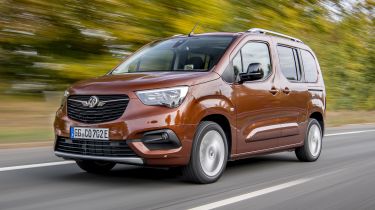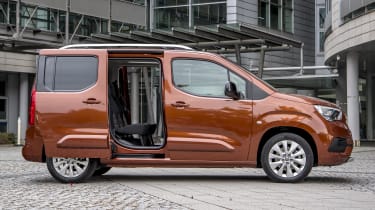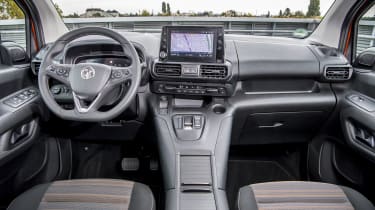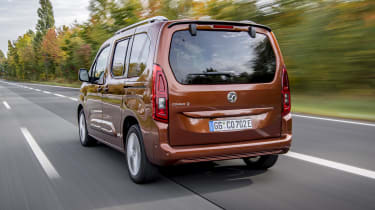Vauxhall Combo Life Electric review
Vauxhall’s zero-emissions van-based MPV is everything you’d expect it to be, but little more
Pros
- Practical
- Spacious
- Smooth to drive
Cons
- Short range
- Van-like styling
- Questionable quality in parts
| Van type | Range | Wallbox charging time | Rapid charge time |
|---|---|---|---|
| Electric | 174 miles | 7hrs 30mins (0-100%, 7.4kW) | 30mins (0-80%, 100kW) |
Vauxhall Combo Life Electric verdict
The Vauxhall Combo Life Electric is by no means the most stylish or scintillating electric car on the market right now. But if practicality is your top priority, then the Vauxhall is a cheap-to-run option that may suit you. The amount of cabin space is generous, the van-derived interior should be able to withstand family use, and the electric powertrain is smooth, quiet and more than strong enough for everyday driving in and out of town.
Range details, specs and alternatives
While SUVs have become the go-to choice for families looking for a more spacious car than your average hatchback, minibuses and MPVs have fallen out of favour. Some consider them less stylish than their wannabe off-road equivalents, yet there’s no avoiding the fact that more often than not, people carriers by definition are better for carrying people.
Vauxhall’s entry into the MPV market is the Combo Life, and – for the interests of us here at DrivingElectric – it’s also available in zero-emission Combo Life Electric guise. Buyers get a choice of both five and seven-seat configurations.
Based on the Vauxhall Combo compact van, it shares its underpinnings with its Stellantis Group siblings the Peugeot e-Rifter and Citroen e-Berlingo. Like them, the Vauxhall features a 134bhp electric motor fed by a 50kWh battery, for a maximum range of 174 miles. While the Vauxhall Mokka Electric – as well as the DS 3, Jeep Avenger and now the Citroen e-C4 – get a longer-range 54kWh battery option and more powerful motor, the Combo Life makes do with the previous-generation technology for now.
Yet the Combo Life Electric will still charge from flat to full in seven hours and 30 minutes from a standard 7kW home wallbox. If you use a 100kW rapid charger, you can get from 0-80% in half an hour.
Its zero-emissions status means it’s exempt from the London Congestion Charge zone and other low-emissions areas for now, and most owners will be able to benefit from lower running costs overall. Plus, its 2% company-car tax rate goes some way to making up for its list price being £6,000 higher than the equivalent diesel version.
Thanks to the batteries sitting under the floor, interior space in the Combo Life Electric hasn’t taken a hit with the switch to electric power. The five-seater model has a 597-litre boot, extending to 2,126 litres when you fold the rear seats down.
The standard version is 4.4 metres long, while the XL extends to 4.75 metres. In five-seat mode, we found there was plenty of head and legroom for all passengers, but three adults sitting across the rear will struggle for shoulder space. In the XL model’s third row there’s a surprising amount of room, even for taller adults. There’s quite a step up to access the seats, though, and they don’t fold flat to the floor as the middle row does. With seven people inside, there’s still a small amount of boot space for a few shopping bags or similar.
The cabin is also packed with storage spaces, and there's the option of extra light if you pay £840 for the panoramic sunroof. However, aside from some chrome-accented trim, the Combo Life Electric’s interior features materials lifted directly from the van it’s based on. That means tough and durable surfaces rather than soft-touch plastics, but the areas the driver interacts with most frequently, like the steering wheel and the climate-control buttons, are a cut above in terms of quality. The same is true for the 10-inch driver's information display and eight-inch central touchscreen, which come as standard.
The driving position is perhaps a little narrow due to the thick door and wide centre console, but the seat is comfortable. There's a choice of three driving modes – Eco, Normal and Power – each of which adjusts the amount of power provided by the motor. Power gives you the full 134bhp for an 11.7 second 0-62mph time, but most will stick with Normal in the interests of maximising range; doing this cuts output to 107bhp. The mode selector also allows you to set the level of regenerative braking.
At the start of our test drive, the Combo Life Electric indicated a range of 165 miles, which was reduced to 130 miles after 20 miles of mixed driving in Normal mode. While this will likely be plenty for many urban adventurers, a lifestyle-orientated car like this would be dramatically more appealing with a 200-mile-plus range – we can only hope Vauxhall deems it appropriate to fit the larger 54kWh battery from the Mokka in the future.
Regardless, the car is extremely quiet on the road, with just a slight electric-motor whine evident at low speeds and barely anything audible above a whisper of wind and road noise at motorway speeds.
The ride is smooth on even surfaces, but can become a little fidgety on rougher roads. The steering is very light, but becomes vague when you have to apply more lock. Thankfully for such a tall car, body lean is well contained – this is due in part to the 350kg of batteries in the floor lowering the centre of gravity.
Prices for the Combo Life Electric in five-seater guise and entry-level Design trim start from over £34,000, while Ultimate spec models will set you back just under £36,000. Vauxhall is famed for its tempting finance deals though – sometimes including 0% APR – so it’s worth checking these out before writing the Combo off on cost alone. Upgrading to the seven-seater XL versions of either model will cost you an extra £600.
Standard kit includes 16-inch alloy wheels along with body-coloured bumpers and side protection mouldings to improve looks – although it's still clearly based on a van. Also standard are parking sensors, a reversing camera, cruise control, speed-limit sign recognition and the eight-inch infotainment touchscreen that features Apple CarPlay and Android Auto.
Upgrading to Ultimate brings dual-zone climate control, a panoramic rear-view camera, tinted windows and extra body-coloured trim. But given the car’s rough-and-tumble, family-ready appeal, we’d stick with the standard car.











